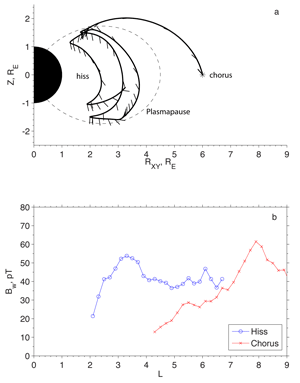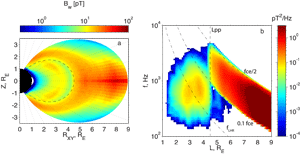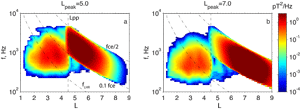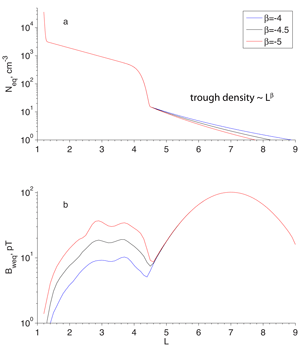
2012 THEMIS SCIENCE NUGGETS
Modeling the Properties of Plasmaspheric Hiss
by Lunjin Chen, UCLA AOS
Introduction
Plasmaspheric hiss (PH), as its name suggests, is a structureless, band-limited, natural electromagnetic emission that is generally confined to the plasmasphere and associated high-density regions such as plumes. There is increasing evidence that plasmaspheric hiss is formed by the evolution of a portion of chorus waves that are excited in the plasmatrough and propagate into the plasmasphere (Figure 1a). In these two companion papers, we use observed statistical distribution of chorus emission to model the characteristics of hiss spectrum and investigate the response of hiss emission to the variations of source chorus and of background plasma density distribution.
| Figure 1. (a) Schematic illustration of the ray path of a chorus wave over 10 seconds, as well as the variation of the wave vector direction during propagation, indicated by the short straight-line segments. The dashed line represents the outer edge of the plasmapause (L = 4.5). (b) Statistical distribution of chorus and hiss wave amplitude from THEMIS observation (8 ≤ MLT ≤ 12). |
Results
Comparison between the statistical spatial distributions of these two emissions in the morning sector during active times from THEMIS over 3 years (2008/6-2011/5) shows that the two emissions have comparable peak intensities but are distinct in their spatial distributions (Figure 1b).
| Figure 2. (a) Spatial distribution of the modeled wave amplitudes in the meridian plane both inside and outside the plasmapause. (b) The modeled equatorial wave frequency spectrum. Dashed line in panel (a) denotes the field line of the outer edge of plasmapause (L=4.5). Dotted lines in panel (a) represent contours of constant latitude from -80O to +80O with a spacing of 10O. Vertical dashed lines in panels (b) represent the outer edge of the plasmapause. The dot-dashed lines in panel (b), from top to bottom, denote 0.5 fce, 0.1 fce, and fLHR respectively. |
The methodology of modeling the hiss spectrum is based on a ray tracing technique. We trace ~ 105 rays from the equator outside the plasmapause, each of which carries properly assigned power, to represent the excited chorus rays. Figure 2 shows the simulation results. The spatial and spectral distributions of hiss emission are well reproduced.
| Figure 3. The modeled equatorial frequency spectrum by using source chorus with intensity peak at L=5 (a) and L=7 (b). |
The simulated hiss spectrum depends on the source chorus distribution. For example, if the chorus source moves closer to the plasmapause, the hiss spectrum shifts to higher frequency (See comparison in Figure 3).
| Figure 4. The modeled equatorial wave amplitude (b) by using the same source chorus distribution but density models with different trough density slopes (a). |
The simulated hiss spectrum also depends on the background plasma density distribution, which controls the propagation of chorus emission and accessibility into the plasmasphere. Figure 4 shows that as trough density slope increases, hiss intensity increases because more chorus rays enter the plasmasphere.
Conclusion
Ray tracing of the observed chorus emission reproduces typical observed characteristics of hiss emission. The hiss spectrum is not only controlled by the spatial and spectral distribution of chorus, which provides the embryonic source for hiss emission, but also depends on the background plasma density distribution, which regulates the portion of chorus rays that are able to propagate into the plasmasphere and subsequently evolve into hiss emission.
References
Biographical Note
Lunjin Chen is a postdoctoral scholar at Department of Atmospheric and Oceanic Sciences, University of California, Los Angeles. His current research involves studying propagation and excitation of plasma waves in the magnetosphere (see http://www.atmos.ucla.edu/~clj/ for more information).
 Please send comments/suggestions to
Emmanuel Masongsong / emasongsong @ igpp.ucla.edu
Please send comments/suggestions to
Emmanuel Masongsong / emasongsong @ igpp.ucla.edu



